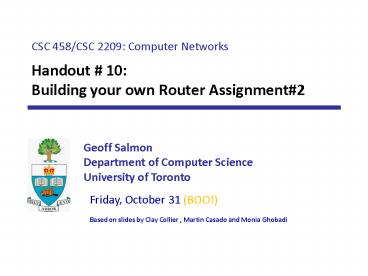Handout - PowerPoint PPT Presentation
1 / 14
Title: Handout
1
Handout 10Building your own Router
Assignment2
Geoff
Geoff Salmon
Friday, October 31 (BOO!) Based on slides by
Clay Collier , Martin Casado and Monia Ghobadi
2
Assignment overview
- You will be given a virtual network topology
- You write a router in C
- Your router will route real packets sent over the
Internet from standard clients (i.e, Firefox) - Each of you has their own router, topologies, and
IP addresses. - Due Friday, November 28th _at_ 5pm
3
VNS
- We will use Stanford University's Virtual Network
System (VNS) for this programming assignments
4
How VNS works?
5
How it really works
VNS Client
Instructional machines
PCLinux
Firewall
Internet
Virtual Network Server
Web/FTP servers
6
How it works in excruciating detail
- Firewall sends ARP request to VNS server
- VNS server forwards ARP request to client
- VNS client send ARP reply to server destined to
the firewall
A
B
Virtual Network Server
Firewall
Application Servers
7
Getting started
- I will email you your topology and rtable
(Ignore Creating Your First Topology section of
assignment) - Download the stub code from the assignment page.
It connects and communicates with the VNS server. - Compile the code and connect to the VNS server
./sr -s vns-1.stanford.edu -t lttopo-idgt
8
Getting started
- After you connect successfully, the server will
send you a description of the host including all
the interfaces and their IP addresses. - The routing table is constructed from the file
rtable and by default consists of only the
default route which is the firewall.
9
Example
10
Example
Routing table is used to decide where to route
packets
11
Forwarding in an IP router
- 1. Remove IP datagram from arriving Ethernet
packet. - 2. Lookup packet DA in routing table.
- If known, determine next-hop IP address.
- If unknown, drop packet and send ICMP message.
- 3. Decrement TTL, update header Checksum.
- If TTL 0, send ICMP message.
- 4. From next-hop IP address, determine outgoing
interface and next-hop Ethernet MAC address. - If necessary, send an ARP packet to determine MAC
address. - 5. Encapsulate IP datagram in Ethernet packet.
- 6. Forward packet to outgoing interface.
12
ARP
- Why do you need ARP?
- Your routing table contains ip addresses for
next hop, however - you send ethernet frames to ethernet addresses
- The web/ftp server and the router that connects
you to the - internet need to know your hardware address
- What you have to do
- Generate ARP requests and parse ARP replies
- Listen to ARP requests and send ARP replies
- Cache ARP replies to avoid sending requests for
every packet - Both ARP requests and ARP cache entries should
timeout - Send ICMP host unreachable messages if ARP
requests fail. (Note Must do this in a fixed
period of time. This is tricky! Read last point
in Required Functionality carefully)
13
Some hints/tips
- Use the logging option -l ltfilenamegt of sr to
write all packets received and forwarded by your
router to a log file . - Use tcpdump (\usr\sbin\tcpdump on CDF machines)
to examine the packets in the log file. - Use -r ltfilenamegt to specify the log file
- Try -v or even -vv for more analysis
- Use -e to print MAC addresses
- Use -x to print out packet in hex, -xx for link
layer headers - Will detect incorrect checksums, malformed
packets etc. - You dont have to deal with
- Multicast
- Broadcast
- IP Header Options
14
For Further Reading
- Read the assignment FAQ
- Peek at the RFC on routers (RFC 1812) but don't
worry too much about it - For ICMP details read the RFC (RFC 792)
- If RFCs are too cryptic to read, try the RFC
sourcebook at Network Sorcery - http//www.networksorcery.com/































